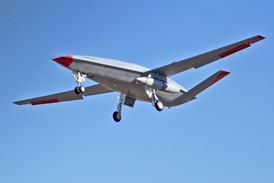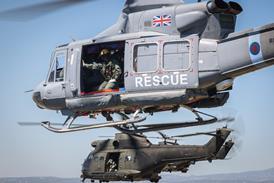The Tiger is entirely designed around its main weapons system: the Osiris mast-mounted sight coupled with the Euromissile Dynamics Group (EMDG) long-range Trigat fire-and-forget anti-tank missile.
The system is totally passive in concept, relying on daylight or thermal imaging for detection, identification and hitting of targets. No range information is required (although a range finder is fitted to the sight for general use). The missile's range is between 500m (1,600ft) and 8km (4.3nm).
In line with modern practice, the Trigat development programme centres on computer modeling, and the "hardware-in-the-loop" concept, in which the missile is put through the full range of simulated tests while remaining on the test bench. This led to the first actual firing of a complete missile (minus warhead) on 10 March, at a range of 3.5km, which was described by EMDG as a "total success".
The Trigat concept emerged from a French/German/UK study in the early 1980s, leading to a contract in 1988 for development of medium-range (man-portable) and long-range versions. The programme was completely re-appraised after the fall of the Berlin Wall, and reconfirmed. The first production missiles are due off the line in 1999.
The infra-red/TV/Low light sight is linked to the missile through the same type of infrared charge-coupled device (IRCCD) as is used in the Trigat seeker. "We have made a quantum leap in thermal imagery with IRCCD technology," says Euromissile marketing chief, David White.
The three field-of-view, zoomable Osiris sight has a much larger thermal window than has the missile seeker, for it to be able to gather the maximum energy over a wide field-of-view. Image-correlation tracking ensures that the missile seekers then stand the best chance of following the image seen by the Osiris. Once the target is identified, a computer-based pixel match between sight and seeker is carried out via the 1553B databus, which results in a "lock-on probability assessment", to help the gunner decide whether to fire. In flight, the missile seeker rotates, to provide the maximum field of view (FOV), and ensure the minimum clutter between the body-mounted warhead and the nose.
The sight is extremely powerful - a demonstration to Flight International revealing that, on a hazy day, from 7km away, small thermal details such as hands, or power lines, were clearly visible. This was even after the Osiris image had been filmed and processed for a video recorder.
The gunner can mark up to four targets with a cursor. The system then auto-tracks, and pre-points the missiles' seekers so that they are ready to lock-onto the targets as soon as the helicopter clears cover sufficiently. All missiles can be released within 8s.
Besides its advanced "eyes", the key to the missile's destructiveness lies in its tandem-charge warhead, which has demonstrated a penetration capability equivalent to "more than 1m thickness" of armour, says EMDG. "The missile will defeat anything on the battlefield today, and against future threats identified by the governments", adds White. The charge is proximity and impact-fused, and the Trigat, which cruises at just below Mach 1.0, can attack the target directly or vertically.
Source: Flight International













